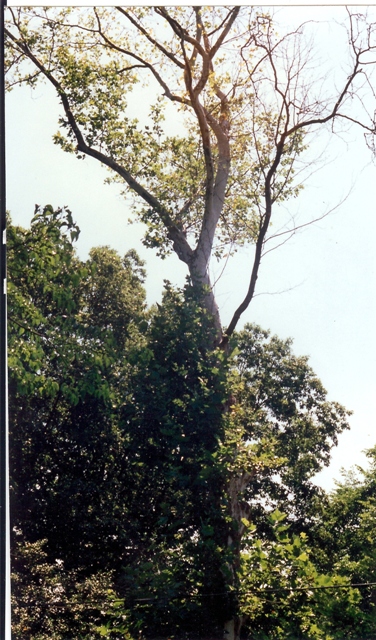
The top of the Keys sycamore is nearly dead and the main trunk is covered with sprouts (above)
February 14, 2010 What to Do When Your Tree is Damaged By a Snowstorm
Let me start with the story of one persons’ misfortune because it is such a powerful learning experience.
“The mysterious case of the death of Mr. Key’s sycamore”.
Ted Key was famous for his cartoons –particularly “Hazel” – which you surely remember if you are of a certain age. Less famously, he also loved his trees.
For me, a visit to his house near Valley Forge was always a delight because he would insist on giving me the tour of his personal little ”arboretum.” He’d always test me, pointing to an unusual specimen such as his beautiful Cunninghamia, and saying “you know what this is?”
One day in 1997 he called and asked me to look at his big sycamore tree. It was suddenly dying and he had no idea why. The whole top of the tree was dead and the trunk was covered with sprout growth. Mr. Key was heartbroken to lose this magnificent tree, but it now needed to be cut down; in this condition it was a threat to the house.
So we cut away the trunk sprouts and the mystery was immediately solved: the bark had evidence of injury due to someone climbing it using climbing spikes. The spike wounds had become the site for a canker disease infection. Each year for the past 5 years, the vulnerable woundwood surrounding the injured tissue was killed by the canker, leaving widening concentric rings of dead wood. After about the 5th year, as the increasing dead areas coalesced, half of the circumference of the trees cambium was killed.
When I explained this to Mr. and Mrs. Key, they both said my conclusion could not be accurate – no one was ever allowed to climb any of their trees using spikes – the Keys knew better. I showed them the concentric canker rings, counting them backwards to the little hole in the middle, and said yes, unfortunately someone did and it was in about 1991. Mrs. Key suddenly said “OH NO! Now I remember!” There had been a nasty ice storm about 6 years before, and some guy knocked on her door and told her that, for the small price of 50 bucks (since he was in the neighborhood) he’d climb up the tree and get the broken branch that was hanging in the top. She agreed, and the man went out to his truck and began to strap on his climbing spikes. Mrs. Key was watching and said “you can’t use spikes, they’ll injure my tree.” The man assured her the injury would be insignificant and it would heal right away, it wasn’t going to hurt the tree. So he did it. 6 years later we knew that she was right and he was wrong. But a terrible way to learn the lesson.
· Don’t panic – it’s not a health emergency for the tree! The tree doesn’t need first aid. It’s not going to bleed to death.
· Don’t panic – once safety issues are resolved – things like broken branches precariously suspended over targets like your house, sidewalk and driveway, there is no longer an emergency.
· Don’t panic – trying to remove heavy snow or ice from trees or shrubs is likely to cause additional damage. The damage is already done. Wait for it to melt. Once the weight is gone, branches often remain bent in position. They may remain “frozen in place” for a while after the weight is gone, but they will recover amazingly as the weather warms. I can then bend some branches back to where they should be, or make targeted pruning cuts so that the subsequent growth will be of the desired form. (If some type of unprofessional hackery occurs before I can do this, it will be much more difficult for me to get the desired results.)
So the message here is – if nothing is blocking your driveway or threatening a target – wait. Wait until the restoration and pruning can be done by someone who knows what they are doing. Improper pruning cuts or those that damage branch collars will cause permanent damage. Malpractice such as this is the biggest potential problem for storm damaged trees.
Malpractice by unqualified handypersons or homeowners poses the greatest threat to the future health of damaged trees.

With the sprouts removed you can see the cankered spike injuries

A lowering device is lashed in place in preparation for the removal . Can you see the spike mark in the center of the concentric rings of canker dieback?


